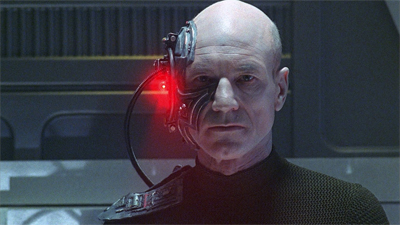Watching Collective, it’s strange to imagine a time when the Borg were considered a credible threat to the larger Star Trek universe.
Collective alludes to this palpable sense of menace in its opening scene. Several members of the crew are playing poker in the Delta Flyer. They are playing in the cockpit, for some reason, rather than in the aft section that would seem to lend itself to such recreational activities. The reason for this storytelling decision comes at the end of the teaser, when something catches Paris’ eye in the middle of one hand. The other members of the away mission follow his gaze, spotting a Borg Cube in the shuttle’s path. Panic ensues. The crew rush to their stations. This, Collective seems to scream, is a big deal.

Baby on Borg.
Of course, this is not actually a big deal. Collective focuses on a Borg Cube that has effectively run aground, a ship that has been disabled. The crew are dead, the result of “a space-borne virus that adapted to Borg physiology” that Child’s Play would reveal to be a form of biological warfare. It should be noted that “the crew discover a disabled Borg Cube” is something of a recurring trope on Star Trek: Voyager, with a similar plot beat employed in both Unity and Scorpion, Part I during the third season. When Kim talks about “bad memories” while skulking through the Cube, it initially seems like he might be referencing the latter.
(Ultimately, Kim is not referring to his traumatic experiences in Scorpion, Part I, which left the character on the verge of death after being attacked by a member of Species 8472. Although the Borg Cube in Collective evokes such memories for the audience, Kim is insulated by Voyager‘s stubborn refusal to acknowledge its own internal continuity. As a result, the memories stoked by the trip to the Borg Cube are generic in nature, of “a haunted house [his] parents took me to when [he] was six.” This is never referenced again. This reveals nothing of Harry Kim. It is just empty filler.)

Dead circuits.
There are plenty of reasons why Voyager keeps stumbling across damaged and derelict Borg Cubes. From a narrative perspective, it allows Voyager to tells stories featuring the Borg without have the crew overwhelmed. Voyager has allowed its characters major victories over the Borg in episodes like Drone or Dark Frontier, Part I and Dark Frontier, Part II, but understands that having a lone lost ship triumph repeatedly over the Borg Collective would strain credulity. So having the ship repeatedly encounter broken-down Borg Cubes allows the series to involve the Borg in these stories while nominally preserving their menace.
However, there is also a sense that there might just be something more at work here, that the sad and story state of the Borg Collective across the seven-season run of Voyager might reflect more than just the demands of the production team. It would seem to hint at a broader sense of social anxieties.

“For the promo!”
Filed under: Voyager | Tagged: anxieth, borg, borg collective, children, social, star trek, star trek: voyager, voyager, youth | 8 Comments »






























